
Saisons de chasse en FORÊT DE TRONÇAIS: Dates clés, Réglementation en vigueur, Types de gibier, Restrictions strictes et Conseils pratiques La Forêt de Tronçais, joyau du département de l'Allier, est un territoire de chasse réputé pour ses majestueux chênes centenaires et sa faune abondante. Chaque année, les chasseurs s'y pressent pour vivre des moments uniques, mais une réglementation stricte encadre cette activité afin de préserver l'équilibre naturel. Comprendre les saisons de chasse, les règles en vigueur et les meilleures périodes pour pratiquer est essentiel pour tout passionné souhaitant évoluer dans ce cadre exceptionnel. Les dates clés et la réglementation en vigueur en Forêt de Tronçais En Forêt de Tronçais, comme dans toute la France, les périodes de chasse sont définies par arrêté préfectoral, en tenant compte des cycles biologiques des espèces et des impératifs de gestion durable. La saison s'étend généralement de septembre à fin février, mais avec des variations notables selon le type de gibier. Les particularités locales influencent ces dates. Le microclimat de la forêt, plus humide et frais que les plaines alentour, affecte les périodes de reproduction et les déplacements du gibier. Ainsi, alors que dans les régions voisines comme le Limousin, la chasse au sanglier peut démarrer plus tôt, en Forêt de Tronçais, les dates sont parfois ajustées pour éviter une pression trop forte sur les populations. Ces dernières années, plusieurs réformes ont modifié le calendrier cynégétique. La plus notable concerne le chevreuil, dont la période de chasse a été réduite pour limiter le prélèvement des femelles. Ces ajustements reflètent une volonté croissante de concilier tradition et conservation. Saisonnalité et types de gibier Pour le grand gibier, l'automne est la saison reine. Dès septembre, les passionnés de chasse à l'approche ou à courre peuvent traquer le cerf, avec un pic d'activité en octobre lors du brame. Ce moment spectaculaire, où les mâles rivaux se défient, offre des opportunités uniques, mais exige aussi une grande éthique pour ne pas perturber la reproduction. Le sanglier, quant à lui, se chasse jusqu'en février, avec des battues organisées en hiver lorsque les cultures alentour sont moissonnées, poussant les animaux à se réfugier dans les bois. Le petit gibier, comme le lièvre ou la perdrix, se pratique plutôt en début de saison, dès l'ouverture en septembre. Les matinées fraîches sont idéales, lorsque les oiseaux sont actifs et que les chiens travaillent dans des conditions optimales. En revanche, dès décembre, la plupart de ces espèces voient leur chasse fermer, marquant la fin des parties en plaine. La Forêt de Tronçais est aussi le cadre d'événements marquants, comme la Fête de la Saint-Hubert, où chasseurs et veneurs se rassemblent pour célébrer leur passion. Ces rendez-vous sont l'occasion d'échanger sur les meilleures pratiques et de perpétuer des traditions séculaires. Restrictions et interdictions en Forêt de Tronçais La réglementation française impose des restrictions strictes pour protéger la faune. Ainsi, il est interdit de tirer les femelles de cerf ou de chevreuil accompagnées de leurs petits, une mesure cruciale pour assurer le renouvellement des populations. Certaines espèces, comme le loup ou le lynx, sont totalement protégées et leur chasse est prohibée. Les périodes de reproduction sont également sanctuarisées. Au printemps, toute chasse est suspendue pour permettre aux animaux de se reproduire en paix. Ces mesures, parfois perçues comme contraignantes, sont indispensables pour garantir la pérennité des espèces et des territoires de chasse. Comment obtenir un permis et éviter les infractions Pour chasser en Forêt de Tronçais, il faut être en possession d'un permis valide, délivré après réussite à l'examen du permis de chasser. Les visiteurs étrangers doivent se renseigner sur les équivalences et les éventuelles validations nécessaires. Les infractions, comme le non-respect des dates ou le prélèvement d'espèces protégées, peuvent entraîner des amendes sévères et la suspension du permis. Mieux vaut donc bien préparer sa saison et se tenir informé des éventuelles modifications réglementaires. Conseils pratiques pour optimiser votre expérience en Forêt de Tronçais Chaque saison demande une approche adaptée. En automne, privilégiez les affûts près des zones de gagnage pour le cerf, tandis qu'en hiver, les battues en groupe sont plus efficaces pour le sanglier. L'équipement doit aussi évoluer : des vêtements chauds et silencieux en hiver, des tenues plus légères en début de saison. La Forêt de Tronçais offre un cadre magnifique pour la chasse, à condition de respecter scrupuleusement ses règles. En jouant le jeu de la gestion durable, les chasseurs contribuent à préserver ce patrimoine exceptionnel pour les générations futures.
Post: 12 September 10:46














































